"Hexagon is a bike camera that turns your smartphone into a rearview mirror" - article about a new Indiegogo funding effort for the solution to end all solutions for bike safety and anti-safety, all wrapped up in one.
Perhaps it goes without saying, but I am not the demographic this sort of thing is supposed to appeal to - but it's still a free country so I am still allowed to express some opinions, right?
It isn't impossible that someone will come up with a good rationale for attaching a smartphone to your handlebars, but so far I have yet to see one, particularly for recreational riders. For one thing, most of the brackets that hold smartphones in place aren't going to keep the smartphone attached if you have a simple falling accident, so in many cases, the phone ends up on the pavement, smashed. But that is secondary to the contradictions of this particular device.
There are a slew of safety features described - you have a turn signal system, a tail light, a brake light, you have a rear view mirror when the camera's view is displayed on the smartphone, it can provide video evidence if something bad happens, and it even provides parents real time information about a child's ride (with its "new generation parental control system" - by which they mean parents who are out of control, I think). It can automatically notify your emergency contacts if you get in an accident! But then there is important anti-safety feature, that this device encourages live streaming of insane stupid bike tricks. ("Amaze your friends with new tricks through live stream functions.")
"Your rides with Hexagon will be more safe, connected, and fun" - apparently I am a curmudgeon.
When the first diamond frame bicycles became popular in the 1890s they were often called "wheels" - the national cycling association was called the "League of American Wheelmen." We have moved from "wheels" to "bikes," but the bicycles have remained remarkably the same over more than 100 years - elegant in their efficiency and simplicity. And many of the issues that we think are new? They were around then too.
Sunday, March 12, 2017
Saturday, March 11, 2017
Epic Bike Rides of the World (Book Review)
 Epic Bike Rides of the World by Lonely Planet
Epic Bike Rides of the World by Lonely PlanetMy rating: 3 of 5 stars
Lonely Planet seems to have decided to publish more specialized guides - although this isn't a take-it-with-you sort of guide but more of a this-may-inspire-you introduction to possibilities for longer distant cycling (generally at some non-trivial expense, by the way).
The format is puzzling. It isn't a coffee table book, but is large-ish format. Physically it reminds me of a high school text book.
The book covers in some detail fifty different possible cycling routes (as they call them) in thirty different countries, organized by region (Africa, Americas, Asia, Europe, Oceania). The number of routes per region varies widely, with all of two for Africa but nineteen for Europe and fourteen for the Americas. The rides are categorized "easy, harder, epic." For each route, there is a "tools" section that gives some information for someone who might actually be considering one of these rides, but since these are mostly not in one's neighborhood and would require considerable preparation, they are just a bare bones start at the research that would be required.
The photography is nice - again, with the idea to perhaps inspire you.
In a nod at how such information would be presented on a web side, each of the fifty routes ends with brief "more like this" section with another three routes covered in a paragraph. Some of these rides were more interesting to me than the ones covered in details - oh well.
The front cover has the blurb, "Explore the planet's most thrilling cycling routes" at the bottom of it. Perhaps I don't think of "thrilling" the right way. Clearly a few of them are in what I would consider attractive for a thrill seeker, but I would say a more accurate blurb would be "the planet's most satisfying cycling routes." But I guess inspiration needs to be for thrills, not satisfaction.
View all my book reviews.
Saturday, March 4, 2017
America's Bicycle Route (Book Review)
 America's Bicycle Route by Michael McCoy
America's Bicycle Route by Michael McCoyMy rating: 5 of 5 stars
The sub-title of this book is, "The Story of the TransAmerica Bicycle Trail." This is a coffeetable format book published by the Adventure Cycling Association, which I learned from reading this book, came into being as the organization headquartered in Missoula, Montana, that led to the 1976 "Bikecentennial," an organized effort to celebrate the bicentennial with an established route and some support for participants to ride across the country - about 4,100 cyclists did so. Wikipedia has a good short entry about Bikecentennial.
The book mixes history of the Bikecentennial and descriptions and photographs of that event in 1976 with description of the TransAmerica Bike Trail that resulted with coverage from the 1970s through to today, as well as profiles of different riders. It's quite well done. Although it is the kind of thing you don't usually sit down and read cover to cover, I have ended up reading a lot of it. The photography is good with the authors having successfully dug up quite a few photos from the 1970s.
Oddly the Adventure Cycling Association doesn't do anything to make this book available to vendors that provide books to public libraries, so I don't think you will find this in any public library. In fact, it doesn't seem to be available from Amazon, even. To get a copy you have to go to the Adventure Cycling Association web site. (I sent the ACA people an email pointing out it would be a good idea to provide a book like this to vendors that sell to libraries - they could probably sell several more copies of the book and get the word out about their association too.)
View all my book reviews.
Sunday, February 26, 2017
Bike Battles: A History of Sharing the American Road (Book Review)
 Bike Battles: A History of Sharing the American Road by James Longhurst
Bike Battles: A History of Sharing the American Road by James LonghurstMy rating: 4 of 5 stars
This book describes the evolution of cyclist use of roads in America, which got its start before the appearance of automobiles. If today there is some recognition of the need for "complete streets," then this is something we have arrived at after considerable evolution, with highs and lows along the way.
If someone is interested in the history of recreational (rather than racing) cycling in America, this book provides an interesting perspective. If you are a regular bicycle commuter as I am, reading this certainly explains the history of how we got to where we are with some, but not (in my view) enough support for cyclists.
The title overemphasizes conflict in this history, as the author admits - "Bike Battles" sounds more interesting than "Selected Cycling Policy Debates." After working his way from the 1800s through to today, the author's advice to cyclist-policy advocates is to take a moderate approach, recognizing that roads are a shared resource, to be used by motorists, cyclists, and pedestrians.
Some of the information and detail was new to me. I had not known much about the "sidepath" movement, which sought to create dedicated bike paths suitable for cycling at a time when roads used by horse-drawn vehicles were often not suitable for bicycling. This movement never got very far and had various misadventures with how it sought public funding. It somewhat presaged the conflicts closer to the present day between those who favor "vehicular cycling," that is, riding in the road as a vehicle with no special infrastructure for cyclists and those who favor such special infrastructure.
The book includes interesting photographs, many from the National Archives, that I had not seen before to make various points. There are also different instructional videos mentioned, many of which can be found on YouTube with a little searching.
While presented as an academic work, with footnotes and a bibliography, the approach is engaging and readable. I was able to find this at my local public library.
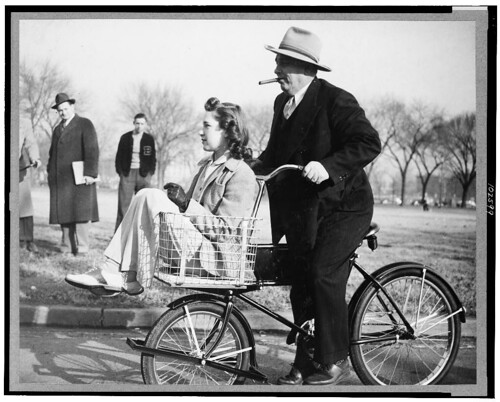
World War II "Victory" bicycle, discussed in the book - a photograph much like this one is include
View all my book reviews.
Saturday, February 25, 2017
Double-Decker Bike Parking for Commuters in USA
![Bicycle shelter, National Cash Register [Company], Dayton, O[hio]](https://c1.staticflickr.com/4/3930/32957219582_6be3423ffb.jpg)
Employee parking in Dayton Ohio in 1902 - back to the future?
![Bicycle shelter, National Cash Register [Company], Dayton, O[hio] - detail](https://c1.staticflickr.com/4/3932/32297952553_b6cf485972.jpg)
Two parking levels of bikes visible in parking shed (or "shelter")
In the detail photograph, you can see clearly that the rider-commuter to the right has a clip (or something) to keep his trousers from getting caught in the front ring of the drive train as well as away from the chain. The fellow in the middle would occasionally work late, it seems, since his bike is outfitted with a headlight.
Bicycle shelter, National Cash Register [Company], Dayton, O[hio]
Contributor Names-Jackson, William Henry, 1843-1942, photographer
Detroit Publishing Co., Created / Published[1902?]
Source Collection-Detroit Publishing Company Photograph Collection
Repository-Library of Congress Prints and Photographs Division Washington, D.C. 20540 USA
www.loc.gov/resource/det.4a20572/
Saturday, February 18, 2017
Another Odd Parked Bike in Neighborhood
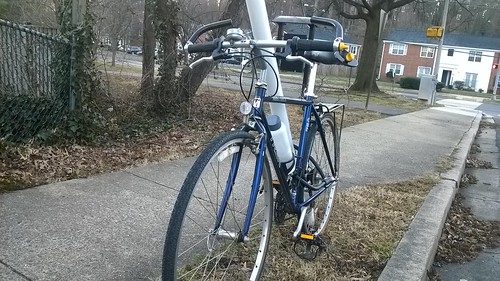
Bicycle parked like this near my house for more than a week
This bike appeared in my neighborhood more than a week ago, locked up to a cable that runs from a phone pole. It isn't doing it much good, sitting out in the weather. It's a Trek 750 "MultiTrack" from around 1995 I would guess.
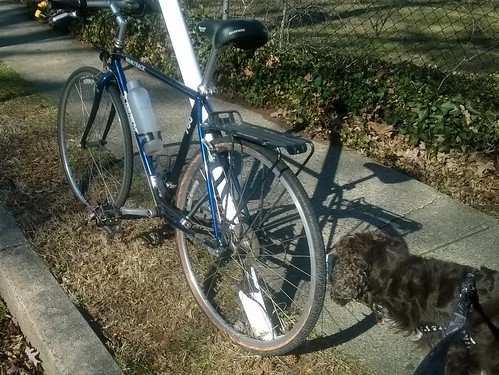
Dog checking it out - yes, it seems to be a bike
This bike is probably about 20 years old - I have a Trek mountain bike of similar vintage, which I like quite a bit. With a little effort a bike like this could be a really good commuter bike. Yet here it is, with its mirror that is falling off, rusting.
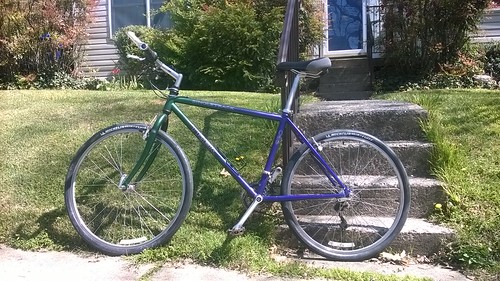
My 1995 Trek 930, which is sort of similar
Saturday, February 11, 2017
What One Sees While Commuting
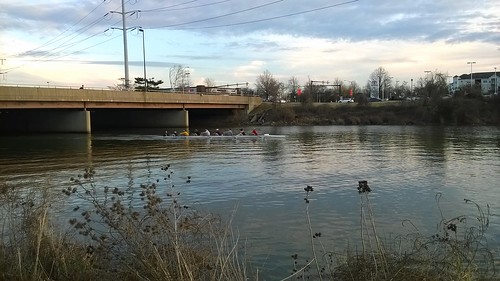
Unusually warm February day brings crew team to Four Mile Run for training
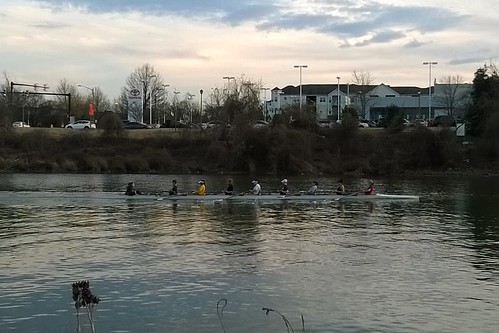
I guess they came up from the Potomac
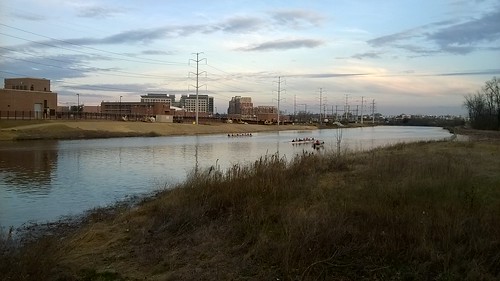
There were in fact two racing shell and a motorboat
Normally my commute is on the other side of Four Mile Run, where the Arlington water treatment plant is, but at the moment cyclists are supposed to use a detour while some work is done along the north bank.
Monday, January 23, 2017
Quick Fix from National Park Service
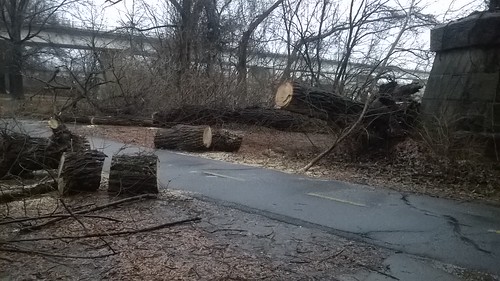
Mount Vernon Trail at rail bridge, near 14th St Bridge -- large tree fell some time after my passing through early in morning rush hour, someone tweeted it was down and NPS must have sent crew to fix it before evening cycling "rush hour" - rush hour in quotes, because the weather was not conducive to much bicycle traffic today. Nice they made the effort to get this taken care of quickly!
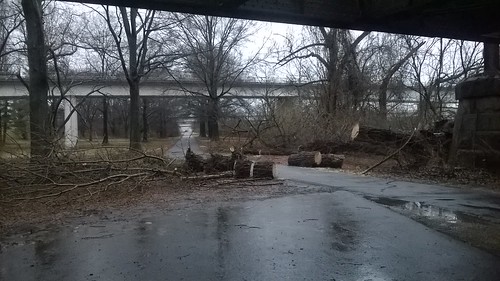
Saturday, January 21, 2017
To the Women's March on Washington by Bike

Bike valet parking at L'Enfant Plaza SW & Independence Avenue
It is about nine miles from my house to where the bike valet parking was set up for the Women's March on Washington - I decided to take my ancient 1973 three-speed Raleigh Sports bike that is indestructible and also not a bike that would be a loss if something bad did happen to it (like it disappeared).
According to the Women's March on Washington web site, there were 1,500 parking spots at this bike valet service for bicycles, which they seemed to suggest would not be enough, but alas the bike valet service was not much used. The above photo was taken at around 9:30, about 30 minutes before the rally started, and there were maybe a few dozen bikes parked total. Hmm. When I left the area around 2:15, heavy crowds extended down Independence Avenue further than this - far too crowded to try to walk a bicycle in that direction - I was able to leave the area by going south, away from Independence, crossing over the railroad tracks and SW freeway on L'Enfant Plaza, then down to Maine Ave and the usual bike route from the Jefferson Memorial area onward across the 14th St Bridge and into Arlington. So for me at least the bike valet parking was well situated.
Given the huge number of people who attended and the stories of how Metro was overwhelmed, it appears bicycle was a good solution, but apparently not an obvious one, although I understand many people came in groups and a group bike ride to something like this probably isn't the first idea one has. Still, the bike valet must have been one of the more over-provided (or under-utilized) resources connected with this event.
Both on the way to the March and on the ride home, I saw more attendees riding Capital Bikeshare bikes than their own bikes.

Listening to speakers at the March
It was an uplifting experience in many ways, even if the historical fact that drove the organizers to create it isn't a positive one in my view. I was glad to be there. Who knows how many people were really there, but Lord that was a lot of people.
Thursday, January 19, 2017
Bikeways : State of the Art, 1974 (Government Report)
Bikeways : state of the art, 1974 / Dan Smith, Jr., author ; prepared for Federal Highway Administration.
Main Author: Smith, Dan.
Language(s): English
Published: Springfield, Va. : distributed by National Technical Information Service, U.S. Dept. of Commerce, 1974.
Subjects: Cycling.
Cycling > United States.
Bicycle trails.
Note: DeLeuw, Cather and Company, performing organization.
Physical Description: v, 97 p. : ill. ; 28 cm.
Available as a public domain government funded document from HathiTrust - https://catalog.hathitrust.org/Record/007473274
It sounds to much like today . . .
Main Author: Smith, Dan.
Language(s): English
Published: Springfield, Va. : distributed by National Technical Information Service, U.S. Dept. of Commerce, 1974.
Subjects: Cycling.
Cycling > United States.
Bicycle trails.
Note: DeLeuw, Cather and Company, performing organization.
Physical Description: v, 97 p. : ill. ; 28 cm.
Available as a public domain government funded document from HathiTrust - https://catalog.hathitrust.org/Record/007473274
It sounds to much like today . . .
With this growth in cycling popularity and utilization have come both a demand for good recreational and utility oriented facilities on which to ride and a concern for the increase in bike involved accidents. The concern for accidents appears well founded despite the fact that only the gross numbers of accidents occurring are known with a reasonable level of accuracy. Very little is known about accident rates associated with the gross numbers. Despite this lack of accident rate information, the following national statistics are significant. In l962, some 570 cyclists were killed and 30,000 injured in bicycle - motor vehicle accidents. By l968, the corresponding figures had grown to 800 killed and 38,000 injured. The National Safety Council's statistics for l972 show l00,000 bicycle - motor vehicle accidents and l,l00 fatalities.
As a result of the growing concern on the part of both the public and public officials at all levels, the past several years have been marked by a veritable blizzard of bicycle safety studies, studies for development of bikeway design and locational criteria, cyclist safety education programs, and provision of physical facilities for bicycles. But the sudden rise in activity and the demand for programs and facilities found planners and designers unprepared and uncertain as to means of responding to these demands. As a result, programs have been planned on the basis of intuitive judgment, what knowledge could be gleaned from European literature on the subject, and trial and error. The result of the past four or five years independent activities undertaken in state jurisdictions across the country has been a broad range of studies, plans, programs, design manuals and in-use facilities with substantial variance and even conflict in recommended practices. The results of initial use and experiences in various localities are now becoming available and it appears that differences in design practices have significant implication for utility and safety.
Tuesday, January 17, 2017
Women's March by Bike?
The Women's March on Washington information about bicycle parking still a work in progress.
According to the what to bring page (which really should be titled, "please don't bring anything!") it seems you are only to have a relatively small, absolutely clear bag if you have any sort of bag at all. I guess I can put a sandwich in my pocket, and an apple. And my phone, which (thanks T-Mobile!) probably won't work but no worries, life proceeded before there were mobile phones.
While it is clear where the March starts, it isn't clear where they are planning to march to, but since it is stated it will be a March of only one and a half miles, it seems like down Independence Avenue to the Washington monument or something like that. Probably best to try to park towards the destination end and walk back to the march start.
Local Transportation - By Bike
Q: Can I bike to the march?
A: You are welcome to ride your bike as transportation to the march. However, bikes are not allowed in the rally area or the march route. We are currently identifying a place for bike parking. We will update people over the next week with more details.
According to the what to bring page (which really should be titled, "please don't bring anything!") it seems you are only to have a relatively small, absolutely clear bag if you have any sort of bag at all. I guess I can put a sandwich in my pocket, and an apple. And my phone, which (thanks T-Mobile!) probably won't work but no worries, life proceeded before there were mobile phones.
While it is clear where the March starts, it isn't clear where they are planning to march to, but since it is stated it will be a March of only one and a half miles, it seems like down Independence Avenue to the Washington monument or something like that. Probably best to try to park towards the destination end and walk back to the march start.
Saturday, January 14, 2017
Seattle Bike Share Failure
Seattle Bike Blog description of the closure, giving considerable detail.
Short Seattle PI online news article briefly on the closure of Seattle's bike share system, Pronto.
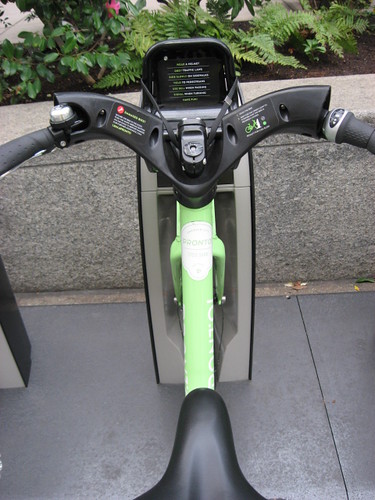
Seattle Dept of Transportation image of a Pronto bike
I lived in Seattle for about fifteen years, but that was in the last century, before cycling was a Seattle "thing" so to speak. I have relatives in the Pac NW so I go back to visit occasionally, and have observed the generally more robust development of cycling and cycling infrastructure there over here, in the Arlington VA and DC area. One of the things that seemed amazing to me was the absence of a bike share program - then once one was introduced in the last few years, called Pronto, that it seemed so lame. (Yes, that is not a very deep analytical comment, I admit.)
Anyway, the Seattle PI item above is an amusing contrast in its brevity to the endless information in the blog post and several items it links to. It appears that just about everything that could be done wrong was. But there are apparently so many villains/possible causes that who knows if any real lessons can be learned.
Because the management of Pronto was so screwed up (according to the accounts) and it was started too small (another theory) combined with the reality of Seattle's hilly terrain combined with bike share bike weight, the issue of Seattle's helmet law is not regarded as a significant factor in the failure. Hmm.
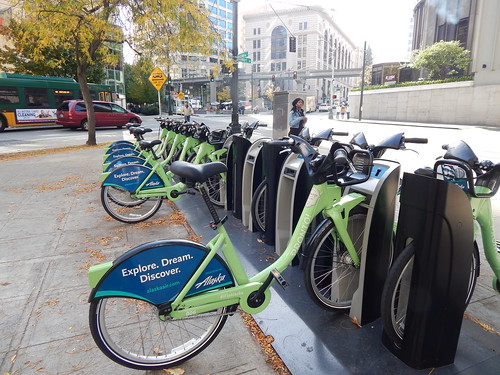
Seattle Dept of Transportation
These are probably the only bike share bikes of this sort of heavy industrial step-through design that have seven speed, not three speed, gearing. Apparently they were still pretty hard to get up some of Seattle's hills.
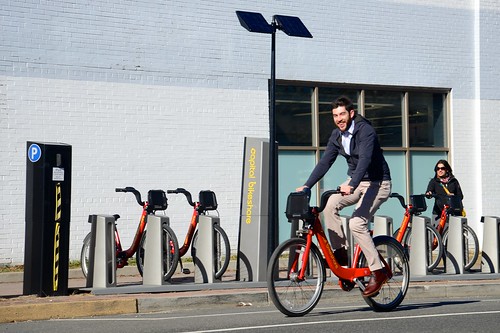
Capital Bikeshare users happy that CaBi continues to flourish, without helmets (by the way)
The Pronto bike share web site (https://www.prontocycleshare.com/faq) which doesn't mention that they are going out of business at this point, speaking admiringly or aspiration-ly about CaBi. "What other cities have bike share and how do they compare? - People are using bike share systems in over 200 cities, including New York, Boston, Washington D.C., San Francisco, Denver, Minneapolis, Chicago, London, Paris, and Barcelona with more programs launching each year. In New York, Citi Bike riders recorded over 10 million trips in 2015. Washington DC's 1,100 bike program was [as in, is] so successful it has already expanded to 2,500 bikes to keep up with demand." - This is a rare case where Seattlites have something nice to say about Washington DC. Oh, and as of now, it is more than 3,500 bikes for CaBi, yeah.
Short Seattle PI online news article briefly on the closure of Seattle's bike share system, Pronto.

Seattle Dept of Transportation image of a Pronto bike
I lived in Seattle for about fifteen years, but that was in the last century, before cycling was a Seattle "thing" so to speak. I have relatives in the Pac NW so I go back to visit occasionally, and have observed the generally more robust development of cycling and cycling infrastructure there over here, in the Arlington VA and DC area. One of the things that seemed amazing to me was the absence of a bike share program - then once one was introduced in the last few years, called Pronto, that it seemed so lame. (Yes, that is not a very deep analytical comment, I admit.)
Anyway, the Seattle PI item above is an amusing contrast in its brevity to the endless information in the blog post and several items it links to. It appears that just about everything that could be done wrong was. But there are apparently so many villains/possible causes that who knows if any real lessons can be learned.
Because the management of Pronto was so screwed up (according to the accounts) and it was started too small (another theory) combined with the reality of Seattle's hilly terrain combined with bike share bike weight, the issue of Seattle's helmet law is not regarded as a significant factor in the failure. Hmm.

Seattle Dept of Transportation
These are probably the only bike share bikes of this sort of heavy industrial step-through design that have seven speed, not three speed, gearing. Apparently they were still pretty hard to get up some of Seattle's hills.

Capital Bikeshare users happy that CaBi continues to flourish, without helmets (by the way)
The Pronto bike share web site (https://www.prontocycleshare.com/faq) which doesn't mention that they are going out of business at this point, speaking admiringly or aspiration-ly about CaBi. "What other cities have bike share and how do they compare? - People are using bike share systems in over 200 cities, including New York, Boston, Washington D.C., San Francisco, Denver, Minneapolis, Chicago, London, Paris, and Barcelona with more programs launching each year. In New York, Citi Bike riders recorded over 10 million trips in 2015. Washington DC's 1,100 bike program was [as in, is] so successful it has already expanded to 2,500 bikes to keep up with demand." - This is a rare case where Seattlites have something nice to say about Washington DC. Oh, and as of now, it is more than 3,500 bikes for CaBi, yeah.
Thursday, January 12, 2017
Ultralight Bike Touring and Bikepacking (Book Review)
 Ultralight Bike Touring and Bikepacking: The Ultimate Guide to Lightweight Cycling Adventures by Justin Lichter
Ultralight Bike Touring and Bikepacking: The Ultimate Guide to Lightweight Cycling Adventures by Justin LichterMy rating: 4 of 5 stars
This was something I picked up at the public library. I suppose since this isn't the kind of guide you take with you, it is an OK book for a library to have, but I should probably buy myself a copy for reference if I am serious about some overnight rides of any sort. Not sure I am.
The concept here is that most bicycle touring is done in with a "heavy" approach, often with special racks for the front and back that have so-called pannier bags attached. The "ulralight" bikepacker instead uses a combination (usually) of handlebar bag, a slightly elongated bag that attaches behind the saddle, and a "frame bag" that fits into the triangle of space under the top bar - between the rider's legs, basically.
I am sympathetic to this approach mostly because of how my approach to commuting evolved - I used to have these ginormous pannier bags for a back rack on the bikes I used to commute. They were silly large, and from time to time I would more or less find enough crap to haul to/from work to fill them. A lot of weight, and eventually I began to feel they were ruining (or at least not helping) my enjoyment of my rides. I started using a messenger bag and found that if I forced myself to live within the smaller amount of space and made better decisions on what to take with me, it was enough.
This book is advocating much the same approach for longer bike trips of various kinds. The two co-authors (Justin Lichter and Justin Kline) have a light style and there is some amusing stuff about travels in Central Asia - well, amusing for me because I am somewhat interested in that region. Note all of their chapters are relevant for me - for example, "bikepacking for speed and endurance" - eh, not so much my interest.
Anyway, they mention somewhere that packing light and staying away from the heavy bags on the front and back on racks can mean better maneuverability, which seems attractive to me, but also that it can be a better approach for older riders. Amen!
Even though I wasn't equally interested in all parts of this book, it's only about 150 pages so I just read it from start to finish. A nice read.
View all my cycling reviews on Goodreads.
Subscribe to:
Posts (Atom)